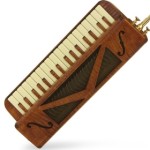Melodica in Roots Rock Acoustic Setting
Tagged: Melodica sound modulation
- This topic has 17 replies, 4 voices, and was last updated 6 years, 11 months ago by
 Alan Brinton.
Alan Brinton.
-
AuthorPosts
-
April 23, 2017 at 10:57 am #8833
 LowboyParticipant
LowboyParticipantHi,
Here is an example of a keyboard harmonica in an acoustic, roots-rock setting.
This is from a rehearsal in a new duo setting: keyboard harmonica with the singer/guitarist/songwriter.
I just placed a stereo mic in the middle of the room and recorded to a Yamaha PocketTrak PR7. We only played the song a couple times so what we hear is potential.
I was playing my usual instrument through a Presonus preamp/compressor/EQ and into a tube amp. There was a lexicon MX300 effects unit in the effect loop providing some delay. I used a Shure Green Bullet mic.
Lowboy
April 24, 2017 at 11:04 pm #8836 Alan BrintonParticipant
Alan BrintonParticipantLovely, distinctive Bootay melodica sound. It doesn’t sound like any other instrument.
April 27, 2017 at 2:59 pm #8846 LowboyParticipant
LowboyParticipantThanks so much for the compliment Alan. That is exactly what I am trying to achieve: a distinctive sound that is instantly recognizable as my sound.
Like BB King, I want to be able to play just one note and have people say, “Oh, that is Lowboy.”
Not that there is lots of keyboard harmonica players out there yet, but I will be ready when the time comes! 🙂
Lowboy
April 27, 2017 at 4:55 pm #8848 Alan BrintonParticipant
Alan BrintonParticipantI remember well your starting out trying to see how much of a harmonica sound you could get, but clearly that experimentation was preliminary to what was to come. At that time, I thought a Toots Thielemans sound was the ideal. I still love Toots, but now I know that’s not where it’s at.
April 28, 2017 at 11:33 am #8849 QuetscherParticipant
QuetscherParticipantHi Lowboy, I just can confirm that your playing is easily recocnisable in the world of melodicas – by your sound, by your style, by your skills…
BTW, I just bought my first (!) Hohner Piano 26 some four weeks ago and I was amazed by the dark and sad sound. I always thought that you did some heavy EQing to get to that sound because I couldn’t imagine that a melodica itself would sound like that – and your idea to use a melodica apron for modifications still gives more distinctive quality to the tone.April 28, 2017 at 12:55 pm #8850 Alan BrintonParticipant
Alan BrintonParticipantWhich Piano 26 did you get, Quetscher? There are three of them. I refer to them as “first series,” “second series,” and “third series” (with the holes in the bottom, the one Lowboy’s playing). The sound is different in all three, but they all have the type of sound you’re referring to, though Lowboy’s techniques accentuate that.
April 28, 2017 at 3:26 pm #8851 QuetscherParticipant
QuetscherParticipantOf course ohne of those with holes in the bottom as I want to try out Lowboy’s playing techniques.
April 29, 2017 at 1:13 am #8852 LowboyParticipant
LowboyParticipantOnce you start achieving expressive sounds, connecting with the instrument physically, holding it tightly against your body, moving it around, letting it fly out over the mic, pushing it against your gut to get diaphragm vibrato, coaxing acoustic vibrato from it by rocking the instrument against your chest, getting ghost notes and bends, you will not want to play any other melodica. You have been warned! Lowboy
April 29, 2017 at 1:36 am #8853 LowboyParticipant
LowboyParticipantHi Quetscher,
The third generation Piano 26/27/32 series sound about as dark as it gets, primarily because the sound holes face down. If you flip the melodica over and play it upside down, it seems much brighter but still has a darker sound than most.
I will never forget receiving several brands of melodicas in the mail on the same day when I first started to explore them. I played the Hohner Piano 3rd generation model last. The moment I heard it, I knew it was the one for me.
Pressing it against your chest really deepens and darkens the sound more, which is the tone I like.
But EQ does play an important roll as it does with any instrument. I like it bright sometimes so that I can play it muffled against my chest and then get a wicked, bright, horn-type stab by lifting the melodica outward.
But mostly I round off the top and middle pretty steeply and boost around 350 or 400 hz. It makes for a very tight compact sound that is dark. Yet the Green Bullet mic and tube distortion still give it some character in the upper frequencies. Or something like that.
Lowboy
April 29, 2017 at 2:45 pm #8854Paul Durham
ParticipantLowboy, when you mentioned receiving several melodicas in one day, You made me feel alot better about having tried almost a dozen this year. I think now I only have to replace sometime the melodyhorn that I gave away. I do miss that one. And one day I do want to get the M37 from Suzuki, but for now the 32 will do.
The thing that has amazed me at this point is the large number of Hohner clones that are out there. Somehow I feel that Hohner hurt their reputation by not insisting on some type of patent protection. But maybe they had been around so long they didn’t feel that was important. I’m a loyalist after all these decades (5) BUT many of these copies are more than adequate and especially off season are bargains.
May 4, 2017 at 1:27 pm #8863 QuetscherParticipant
QuetscherParticipantLowboy, thanks for the warning but I already lost my sanity quite a long time ago (must’ve been around the time when I bought my first melodica:-), so no worries, I knew what would happen when I bought the Piano 26…
It’ really a great instrument although I have to admit that I don’t like the playing position pressed against the chest. Actually I’m searching for a way to modulate the sound while holding it in the conventional way – I have an idea how to realise this but it’ll take a little time and work. In the meantime thank you for summarizing your experiences with sound and EQing.
Greetings, Quetscher
May 4, 2017 at 1:51 pm #8864 Alan BrintonParticipant
Alan BrintonParticipantI have been experimenting, Quetscher, using masking tape to cover all the holes and then trying different combinations by poking combinations of them open.
If no holes are open, the HM-26 is not playable. If too few are open or in a wrong configuration, some notes choke. The combination shown at the bottom works pretty well, and the Bootay effect can be produced to some extent working just the hole at the far left (lower) end, with the thumb of the left hand. But this is very awkward to do and requires propping the melodica between my knee and my mouth, and the results are not as good as with Lowboy’s technique. The same can be done with the Cassotto, with which it’s easier. I’m still experimenting and also looking at a few other melodicas that emit some of their sound through holes or slots, though they don’t do this as strongly as the Hohners do.
Notice that the two holes on the far right are open and not covered with tape.
May 4, 2017 at 2:20 pm #8865 LowboyParticipant
LowboyParticipantYes Quetscher, holding the melodica against you body takes some getting use to. It is not easy at first. It feels really foreign and awkward as does any new experience: riding a horse, trying to play a trumpet, using a new software package.
However, when you do push yourself for a time period to come accustomed to it, the physical connection starts to feel good and I don’t think any mechanical means is going to provide the range of expression, modulation, and feeling you can get from a full-body/melodica interface experience. There are scores of variables and variations.
I would not discourage you from trying another means of course. Do explore. Maybe a better idea exists. But don’t give up too fast the Bootay technique. It is simple and effective and most expressive. It feels good.
Regards,
Lowboy
May 4, 2017 at 2:32 pm #8866 QuetscherParticipant
QuetscherParticipantThanks a lot Lowboy, I’ll keep that in mind! I just feel a little constricted when a hold it like that and I’d love to grab the melodica like a clarinet and be able to move while playing. But the effect I’m intending is the Bootay effect of course. Thinking about a “cage” for the Piano 26 and a cover for the holes that I can move backward and forward with my left thumb and some springs, but as I said this will take some time and work…
Alan, this is fantastic! I’ll try this soon. Thanks a lot!
May 4, 2017 at 3:50 pm #8867 LowboyParticipant
LowboyParticipantYes. I know what you mean, but maybe I have not made it clear that holding the melodica in a “normal” position is also a big part of the technique.
It’s not all about muffling the melodica against your chest. The muffling and modulations bring the contrast and expressiveness to the “normal” sound of the melodica when it is in the traditional position.
Without brightness and a straight tone, you would not have the darkness and modulated tones of the Bootay technique. You must have both.
I have the melodica raised from my chest a significant amount of time. I move it toward and away from the mic to get Doppler, volume, and proximity-effect modulations. It looks cool visually (entertaining) to see the player wave it around in the air. When EQ’ed a certain way, the melodica is wicked bright and has tons of harmonics in the normal playing position, and it is wicked dark and muffled when pressed against you chest. Then there are a 100 shades in between based on how you move the instrument. This is the secret. You must have both. I don’t think you will get that with a cage and a mechanical shutter.
So the most expressiveness comes from combining all the techniques together in various ways.
By the way, I am planning on enlarging the holes on the back cover or cutting big chunks out of the back cover as an experiment to increase modulation capability. I will be trying that one of these months and of course providing you with the results.
Regards,
Lowboy
-
AuthorPosts
- You must be logged in to reply to this topic.

